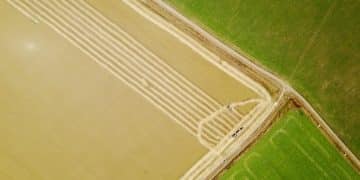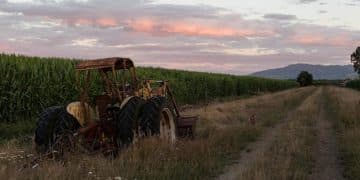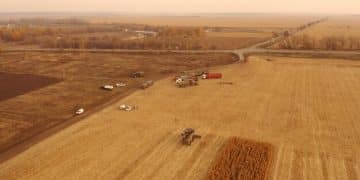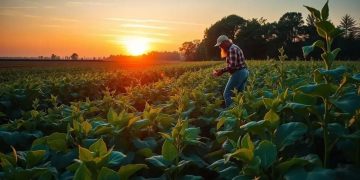Blockchain in Agriculture: Revolutionizing Food Traceability and Safety

Blockchain technology is transforming agriculture by providing enhanced traceability and food safety, enabling consumers to track the journey of their food from farm to table.
The agricultural industry faces increasing pressure to ensure the safety and traceability of food products. The Role of Blockchain in Agriculture: Enhancing Traceability and Food Safety is becoming increasingly important as consumers demand more transparency in the food supply chain.
Understanding Blockchain Technology in Agriculture
Blockchain technology, initially known for its role in cryptocurrencies, is now finding applications across various industries, including agriculture. Its decentralized and transparent nature is particularly well-suited for addressing the challenges of traceability and food safety in the agricultural sector.
In agriculture, blockchain can create a tamper-proof record of every transaction and movement of goods along the supply chain. This includes data on planting, harvesting, processing, packaging, and distribution. By providing a complete and verifiable history, blockchain helps to build trust among stakeholders and ensures the integrity of food products.
Key Features of Blockchain for Agriculture
- Decentralization: No single entity controls the information, reducing the risk of manipulation.
- Transparency: All participants can access and verify the data recorded on the blockchain.
- Immutability: Once data is recorded, it cannot be altered, ensuring the integrity of the information.
- Security: Cryptographic techniques protect the blockchain from unauthorized access and fraud.
By leveraging these features, blockchain can significantly improve the efficiency and reliability of agricultural supply chains. This leads to greater consumer confidence and reduced risks of foodborne illnesses or fraud.
Enhancing Traceability in the Food Supply Chain
One of the most significant applications of blockchain in agriculture is enhancing traceability. Traditional supply chains often involve multiple intermediaries, making it difficult to track the origin and journey of food products. Blockchain offers a solution by providing a transparent and immutable record of all transactions.
Traceability is crucial for ensuring food safety and quality. In the event of a contamination or recall, blockchain can quickly identify the source of the problem and trace the affected products. This can minimize the impact of the issue and prevent further harm to consumers.

How Blockchain Enables Traceability
- Real-time Tracking: Enables tracking of products from farm to consumer in real-time.
- Data Integrity: Ensures that all data is accurate and tamper-proof.
- Reduced Fraud: Minimizes the risk of counterfeit or adulterated products entering the supply chain.
- Faster Recalls: Streamlines the process of identifying and recalling affected products in case of contamination.
Companies are already implementing blockchain-based traceability systems to improve their supply chain management. These systems allow consumers to scan a QR code on a product and access detailed information about its origin, processing, and transportation. This level of transparency enhances trust and builds brand loyalty.
Improving Food Safety with Blockchain
Food safety is a top priority for both consumers and producers. Blockchain technology can play a critical role in improving food safety by providing a verifiable record of the conditions under which food products are grown, processed, and transported. This transparency helps to identify and address potential risks before they impact consumers.
By recording data on temperature, humidity, and storage conditions, blockchain can ensure that food products are handled properly throughout the supply chain. This can help to prevent spoilage and reduce the risk of foodborne illnesses.
Benefits of Blockchain for Food Safety
- Monitoring Conditions: Tracks environmental conditions to ensure proper handling and storage.
- Reducing Contamination Risks: Identifies potential sources of contamination and enables quick response.
- Verifying Certifications: Ensures that products meet the required safety and quality standards.
- Enhancing Consumer Trust: Provides consumers with confidence in the safety and quality of food products.
Blockchain can also be used to verify the authenticity of certifications, such as organic or fair trade labels. By providing a transparent and verifiable record, blockchain can help to combat fraud and ensure that consumers are getting what they pay for.
Challenges and Opportunities in Blockchain Adoption
While the potential benefits of blockchain in agriculture are significant, there are also challenges to its widespread adoption. These include the complexity of implementing the technology, the need for collaboration among stakeholders, and the cost of infrastructure upgrades.
Despite these challenges, the opportunities for blockchain in agriculture are substantial. As the technology matures and becomes more accessible, it has the potential to transform the way food is produced, processed, and distributed.
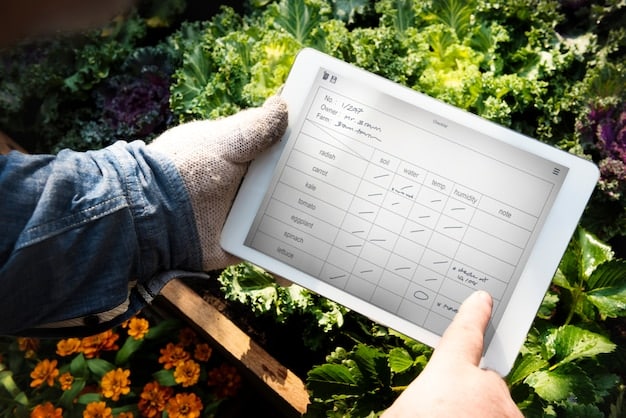
Overcoming Adoption Barriers
- Education and Training: Providing farmers and other stakeholders with the knowledge and skills needed to use blockchain technology.
- Standardization: Developing industry standards for blockchain implementation to ensure interoperability.
- Collaboration: Fostering cooperation among farmers, processors, distributors, and consumers.
- Government Support: Providing funding and regulatory frameworks to encourage blockchain adoption.
By addressing these challenges, the agricultural industry can unlock the full potential of blockchain and create a more transparent, efficient, and sustainable food system. This will benefit both producers and consumers by ensuring the safety and quality of food products.
Real-World Examples of Blockchain in Agriculture
Several companies and organizations are already implementing blockchain solutions in agriculture. These real-world examples demonstrate the practical benefits of the technology and its potential to transform the industry.
For example, Walmart has partnered with IBM to use blockchain to track the origin and movement of mangoes. This has allowed them to reduce the time it takes to trace a product from farm to store from days to seconds. Other companies are using blockchain to track coffee, seafood, and other agricultural products.
Case Studies in Blockchain Agriculture
These examples highlight the vast potential of blockchain in various agricultural applications, showcasing its versatility and adaptability.
- Walmart’s Mango Traceability Program: Reduced traceback time from weeks to seconds using IBM Food Trust.
- Starbucks’ Coffee Tracking: Implemented blockchain to track coffee beans from farm to cup, ensuring ethical sourcing.
- Provenance’s Seafood Tracking: Improved traceability of seafood products, combating illegal fishing and fraud.
These initiatives demonstrate how blockchain can drive transparency, efficiency, and sustainability in the agricultural sector, setting a benchmark for others to follow.
The Future of Blockchain in Agriculture
The future of blockchain in agriculture looks promising. As the technology continues to evolve and becomes more integrated into farming practices, it has the potential to create a more resilient, efficient, and sustainable food system.
Blockchain can also enable new business models, such as direct-to-consumer sales and decentralized marketplaces. This can empower farmers by giving them more control over their products and prices. Furthermore, the integration of AI and IoT with blockchain can provide even greater insights and automation in agricultural processes.
| Key Point | Brief Description |
|---|---|
| 🌱 Traceability | Real-time tracking of agricultural products from farm to consumer. |
| 🛡️ Food Safety | Ensuring product safety through transparent condition monitoring. |
| 🤝 Collaboration | Enhancing cooperation among all stakeholders in the supply chain. |
| 📊 Efficiency | Streamlining processes and reducing fraud in the agricultural sector. |
Frequently Asked Questions (FAQ)
▼
Blockchain is a decentralized, immutable ledger that records transactions across many computers. This makes it secure and transparent, as no single entity controls the information, and all participants can verify the data.
▼
Blockchain provides a transparent and tamper-proof record of each step in the food supply chain, from farm to consumer. This allows for quick identification of the source of contamination, reducing recall times and enhancing food safety.
▼
The main benefits include improved traceability, enhanced food safety, reduced fraud, increased efficiency, and greater transparency. These advantages build trust among stakeholders and ensure the integrity of agricultural products.
▼
Challenges include the complexity of implementing the technology, the need for collaboration among stakeholders, and the cost of infrastructure upgrades. Education, standardization, and government support can help overcome these challenges.
▼
Yes, many blockchain-based traceability systems allow consumers to scan a QR code on a product to access detailed information about its origin, processing, and transportation, enhancing transparency and consumer confidence.
Conclusion
In conclusion, the role of blockchain in agriculture is transformative, offering enhanced traceability, improved food safety, and increased transparency. While challenges remain in its widespread adoption, the potential benefits for both producers and consumers are significant, paving the way for a more resilient, efficient, and sustainable food system.


